Dow 40,000, SPX 4,000: Is this Fed-Fueled Stock Rally Sustainable?
Since stocks rise when the Fed is adding assets and tank when the Fed pauses...
Now that financial pundits are claiming the current stock market rally is good to go until 2016, it's appropriate to see where the market will be in 2016 if current trends hold.
Let's start with the well-known correlation between the Federal Reserve's balance sheet and the stock market: stocks rise when the Fed is adding assets and tank when the Fed pauses. (Chart courtesy of STA Wealth Management)
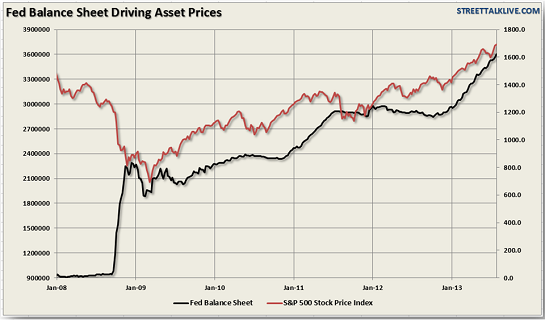
Courtesy of Market Daily Briefing, let's look a little closer at the Fed's ballooning holdings of home mortgages (MBS) and Treasury bonds, and extend those trends into the future:
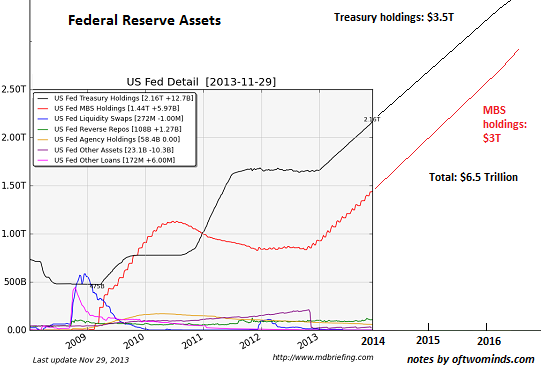
By mid-2016, the Fed will have nearly doubled its Treasury bonds from $2.16 trillion to over $3.5 trillion, and its mortgage holdings will double from $1.44 trillion to $3 trillion. This would represent about a third of total mortgages outstanding.
Here is the Fed's aggregated balance sheet, with the start of each quantitative easing (QE) program indicated:
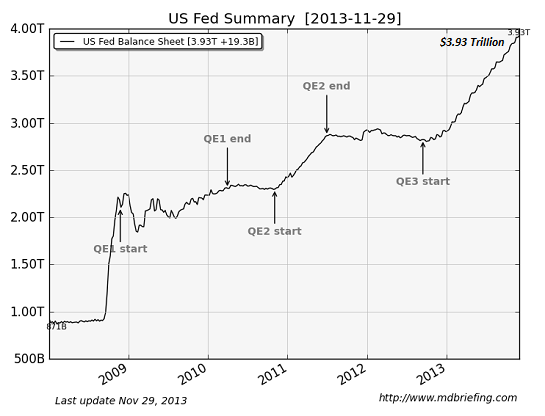
Grab a ruler and pencil and extend this trendline--you reach about the same target of Fed assets $6.5 - $7 trillion by 2016:
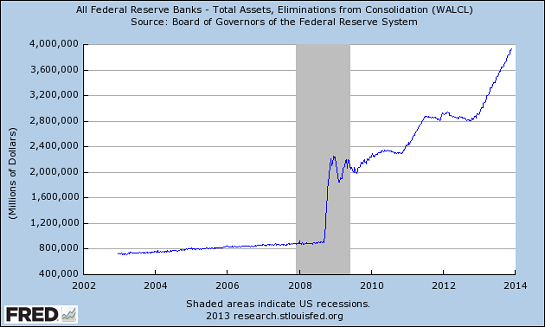
If the S&P 500 (SPX) continues higher in lockstep with the Fed's expanding balance sheet:
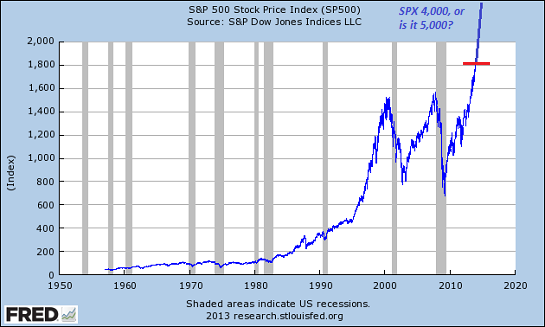
Is that SPX 4,000 in 2016, or is it SPX 5,000? The upward trendline is so steep it's hard to project.
Is this uptrend sustainable? You're kidding, right? Don't fight the Fed, Baby--it's Dow 40,000 or 50,000/SPX 4,000 or 5,000 by 2016, guaranteed.
Please note this is sarcasm, not a forecast.
If You Seek Practical Gifts, Consider These Everyday Kitchen Tools
The Nearly Free University and The Emerging Economy:
The Revolution in Higher Education
Reconnecting higher education, livelihoods and the economyWith the soaring cost of higher education, has the value a college degree been turned upside down? College tuition and fees are up 1000% since 1980. Half of all recent college graduates are jobless or underemployed, revealing a deep disconnect between higher education and the job market.
It is no surprise everyone is asking: Where is the return on investment? Is the assumption that higher education returns greater prosperity no longer true? And if this is the case, how does this impact you, your children and grandchildren?

We must thoroughly understand the twin revolutions now fundamentally changing our world: The true cost of higher education and an economy that seems to re-shape itself minute to minute.
The Nearly Free University and the Emerging Economy clearly describes the underlying dynamics at work - and, more importantly, lays out a new low-cost model for higher education: how digital technology is enabling a revolution in higher education that dramatically lowers costs while expanding the opportunities for students of all ages.
The Nearly Free University and the Emerging Economy provides clarity and optimism in a period of the greatest change our educational systems and society have seen, and offers everyone the tools needed to prosper in the Emerging Economy.
Read the Foreword, first section and the Table of Contents.
print ($20) Kindle ($9.95)
Things are falling apart--that is obvious. But why are they falling apart? The reasons are complex and global. Our economy and society have structural problems that cannot be solved by adding debt to debt. We are becoming poorer, not just from financial over-reach, but from fundamental forces that are not easy to identify. We will cover the five core reasons why things are falling apart:
 1. Debt and financialization
1. Debt and financialization2. Crony capitalism
3. Diminishing returns
4. Centralization
5. Technological, financial and demographic changes in our economy
Complex systems weakened by diminishing returns collapse under their own weight and are replaced by systems that are simpler, faster and affordable. If we cling to the old ways, our system will disintegrate. If we want sustainable prosperity rather than collapse, we must embrace a new model that is Decentralized, Adaptive, Transparent and Accountable (DATA).
We are not powerless. Once we accept responsibility, we become powerful.
Kindle: $9.95 print: $24
| Thank you, Howard R. ($10), for your much-appreciated generous contribution to this site-- I am greatly honored by your support and readership. |



























